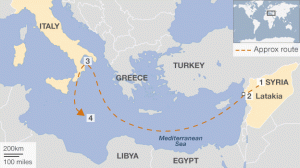Toxic
Malta might soon have to worry about a more real danger than Syrian refugees. Not that Syrian (or any other) refugees are dangerous. The boat carrying Syrian chemical weapons that left Latakia port on Tuesday carries a much more lethal threat than any amount of refugees could ever (even potentially) be. BBC News reported that a Danish vessel, escorted by Russian and Chinese warships, left the Syrian port loaded with the confiscated chemical weapons. So far so good.
What they will do with the weapons is the real problem. The UN has confirmed that the Danish boat is carrying what are termed as “priority one chemical materials” – not your average bleach or dettol. In fact the BBC report continues “the “most critical” chemicals include about 20 tonnes of the blister agent sulphur mustard”. Sulphur mustard eh. It’s a good thing that they have been removed from the hands of evil warlords prepared to use them on innocents. But where will all the sulphur mustard be taken? Here is the BBC again, explaining the steps:
1. The Syrian authorities are responsible for packing and safely transporting the chemical weapons from 12 sites across the country to the port of Latakia. Russia has supplied large-capacity and armoured lorries, while the US has sent container drums and GPS locators.
2. Russia will provide security for loading operations at Latakia, for which the US has supplied loading, transportation and decontamination equipment. China has sent 10 ambulances and surveillance cameras, and Finland an emergency response team in case of accidents.
3. Denmark and Norway are providing cargo ships and military escorts to take the chemicals to an as yet unnamed port in Italy. Russian and China will also provide naval escorts.
4. In Italy, the “most critical” chemical agents will be loaded onto the US Maritime Administration cargo ship, MV Cape Ray, to be destroyed by hydrolysis in international waters. Less-toxic chemicals will be shipped by Norwegian and Danish vessels for disposal at commercial facilities.
Do not be deceived by the MV in the US vessel’s name. It stands for “motor vessel” and does not mean that Malta is involved in any way. Now I confess to absolute ignorance as to the process of “hydrolisis” and what it does to “priority one chemicals” such as “sulphur mustard”. What I do find of considerable concern is the location where the destruction of the chemical weapons is to take place. Here is the BBC “approximative” map:
See what I am getting at? That number 4, approximate as it is, could not be any closer to Malta. Given that the Mediterranean is not exactly huge once you remove territorial and national waters, it should be of some concern – at least to those who are entrusted with the government and welfare of our nation – that this internationally concerted plan involves the destruction of very dangerous chemicals so close to the waters of our island nation.
The least we could have is more information. If our political establishment took a break from the navel gazing they might even find out what is happening in our back yard.
Further Info
An ABC News report on the MV Cape Ray. It includes this very reassuring paragraph: “It’s currently being outfitted with two Field-Deployable Hydrolysis Systems (FDHS), which the Pentagon began procuring in February 2013, knowing it might need a way to destroy Syrian chemical-weapons components in the field. It did not expect to do so at sea, and the equipment had to be tested for vibrations, the sloshing of liquids, and other potential problems.”
Have you ever destroyed chemical weapons at sea before?
Erm no. But we’re outfitting our vessel and we will do our best to contain “sloshing liquids”. There’s always a first time you know.









Once again, the West clearing up everyone else’s crap.